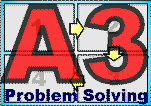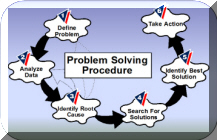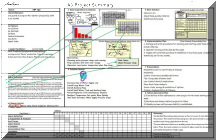A3 Problem Solving & Root Cause Analysis
For Persistent Problems In Quality, Maintenance, & Processes

A3 Problem Solving
A3 Problem Solving is a methodology for addressing a wide variety of problems. It is especially effective for those difficult, recurring problems that never seem to really get resolved. The results are remarkable. Here are some examples from our past clients:
-
Product color on an extruder shifts mysteriously in the first few hours of the morning shift.
-
The position of a bar code on a credit card processing line sometimes shifts for no apparent reason.
-
A high proportion of interconnection cables are scrapped in a firm that manufactures sophisticated electronic equipment.
-
It required an average of six months to install a fiber optic line for new customers when the actual work time was only a few weeks.
-
In a large construction firm, subcontractor contracts are delayed and rejected by the legal department repeatedly.
In most of the these examples, the problems and solutions seem obvious. However, in every instance the problem had existed for years or even a decade. And these examples all came from established, competent and successful firms. How could these situations be allowed to continue for so long? The causative factors hide behind misinformation, intermediate causes and sloppy thinking.
Why Problems Persist
Problem Solving In Casablanca

"Major Strasser has been shot.
Round up the usual suspects..."
Jump to Solutions
There is a strong tendency in many people to jump from a assertion of a problem to the solution or even confuse the solution with the problem.
Rush to Judgment
These problems often seem urgent. Machines may be producing scrap or multi-million dollar projects are being delayed. In other situations, the problem may seem trivial at the time and there is pressure to dispose of it quickly.
Insufficient Investigation
Jumping to solutions and the rush to judgment result in insufficient investigation. The root cause is not found and the solution does not solve the problem.
The Onion Effect
Persistent problems indicate that the root cause has not been identified. Often, this root cause is buried under layers of apparent causes.
In the subcontract problem above, the first apparent cause was that the legal department was being too critical of the proposed subcontracts and taking too much time to approve them. Investigation showed that this was not the case; the errors were egregious and were processed very quickly. There were, in fact, several causes but one of the root causes was a corporate culture in which verbal agreements and a handshake were sufficient for a contract and a formal contract was a lot of legal bother.
Lack of Consensus
When various stakeholders disagree about a problem and its solution, implementation of the solution will not have full support and often fails, even if it happens to be a good solution.
Haphazard Implementation
Even when the root cause is identified and a good solution is found, implementation may be handed off to people who have little appreciation for the severity or nuances of the issues. As a result, implementation becomes haphazard and critical elements may be short cut.

The Role of Teams
Teams are particularly important in finding the root causes of persistent problems. They bring together different viewpoints, uncover hidden information and force discussion and debate. While the A3 procedure could, in principle, be effective for individual problem solving, the team approach brings an entirely new dimension.
Team behaviors are not always intrinsic and must sometimes be learned. These behaviors should be part of the team's training.
The Cycle of Solutions
A3 uses a general procedure for analyzing problem situations finding the root cause and developing solutions. Several such procedures are available. Some are based on Six Sigma or DMAIC. Strategos, we prefer the procedure shown at right. It is based on TQM Problem Solving and is relatively jargon-free. No previous training is required.
The procedure, whichever is adopted, helps prevent the Rush-To-Judgment, Jump-To-Solutions and Insufficient-Investigation effects noted earlier. It provides a framework that helps the team progress in an orderly way.
The A3 Summary
The A3 Summary is an 11x17 form (Approx. A3) that the team fills in as they proceed through the problem-solving process. There are many versions of this form. Most are similar to the example here.
The form has a section for each step of the problem-solving procedure. It also has sections for general information and schedule progress.
By following and filling out the form as they proceed, the team stays focused on their particular step in the problem solving procedure. Lack of such focus has always been the primary reason that teams fail or take excessive time to find good solutions.
The form also reminds the team of the tools they have available and encourages use of these tools. Finally, the form helps them to organize their management presentation and usually becomes a part of that presentation, It builds self-confidence in the team and demonstrates their rigor and thoroughness.
Free Download Includes:
- A3 Form (xls)
- A3 Problem Solving article (pdf)
- Normalization of Deviation article
About A3
A3 Problem Solving takes its name from the A3-size (11x17) sheet that summarizes each project. The tools and techniques have a long history dating back to "Work Simplification" in the 1940's. The tools were adopted by the Total Quality Management movement and then by Six Sigma.
The A3 Summary is new and its effects on team performance are quite remarkable.
A3 Problem Solving Training from Strategos
■ ■ ■ ■ ■ ■ ■




